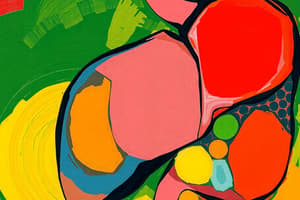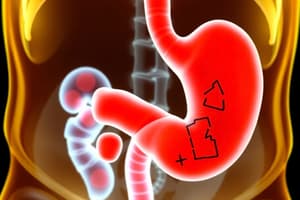Podcast
Questions and Answers
What are the 5 F's associated with gallstone risk?
What are the 5 F's associated with gallstone risk?
- Fasting, Female, Fertile, Fifty, and Family history
- Food, Fiber, Fluid, Focus, and Family history
- Fat, Fiber, Fertile, Forty, and Family history
- Fat, Female, Fertile, Forty, and Family history (correct)
What is the medical term for gallstones?
What is the medical term for gallstones?
Cholelithiasis
What is the primary symptom associated with biliary colic?
What is the primary symptom associated with biliary colic?
- Fever and lethargy
- Severe, colicky pain in the epigastric or RUQ (correct)
- Nausea and vomiting
- All of the above
What is a characteristic sign of acute cholecystitis?
What is a characteristic sign of acute cholecystitis?
Which of the following laboratory tests are typically elevated in acute cholecystitis?
Which of the following laboratory tests are typically elevated in acute cholecystitis?
Most gallstones are radiopaque and will show up on X-ray or CT scans.
Most gallstones are radiopaque and will show up on X-ray or CT scans.
What is the first-line investigation for gallstones?
What is the first-line investigation for gallstones?
What is the preferred surgical treatment for symptomatic gallstones or complications?
What is the preferred surgical treatment for symptomatic gallstones or complications?
What is the medical term for the histological presence of gastric mucosal inflammation?
What is the medical term for the histological presence of gastric mucosal inflammation?
Which of the following is a common cause of gastritis?
Which of the following is a common cause of gastritis?
Dyspepsia is a common symptom of gastritis.
Dyspepsia is a common symptom of gastritis.
What is the medical term for the leakage of gastric acid from the stomach back into the esophagus?
What is the medical term for the leakage of gastric acid from the stomach back into the esophagus?
Which of the following is a risk factor for GERD?
Which of the following is a risk factor for GERD?
Pregnancy is a risk factor for GERD.
Pregnancy is a risk factor for GERD.
What is the gold standard for anti-reflux surgery?
What is the gold standard for anti-reflux surgery?
What is the medical term for inflammation of the pancreas?
What is the medical term for inflammation of the pancreas?
Which of the following is a common cause of pancreatitis?
Which of the following is a common cause of pancreatitis?
What is a characteristic symptom of acute pancreatitis?
What is a characteristic symptom of acute pancreatitis?
Pancreatitis is a relatively common disease.
Pancreatitis is a relatively common disease.
What is the first-line investigation for pancreatitis?
What is the first-line investigation for pancreatitis?
What laboratory test is typically elevated in acute pancreatitis?
What laboratory test is typically elevated in acute pancreatitis?
Pancreatic necrosis is a serious complication of pancreatitis.
Pancreatic necrosis is a serious complication of pancreatitis.
Flashcards
Gallstones
Gallstones
Small stones formed in the gallbladder, often of cholesterol.
Risk factors for gallstones
Risk factors for gallstones
Factors increasing the chance of gallstone formation, including diet, gender, fertility, age, and family history.
Biliary colic
Biliary colic
Pain in upper abdomen, often triggered by a meal, lasting 30 minutes to 8 hours.
Acute cholecystitis
Acute cholecystitis
Signup and view all the flashcards
Murphy's sign
Murphy's sign
Signup and view all the flashcards
Laboratory tests for gallstones
Laboratory tests for gallstones
Signup and view all the flashcards
Ultrasound findings in gallstones
Ultrasound findings in gallstones
Signup and view all the flashcards
MRCP
MRCP
Signup and view all the flashcards
Laparoscopic cholecystectomy
Laparoscopic cholecystectomy
Signup and view all the flashcards
Post-cholecystectomy syndrome
Post-cholecystectomy syndrome
Signup and view all the flashcards
Gastritis
Gastritis
Signup and view all the flashcards
Alarm symptoms (gastritis)
Alarm symptoms (gastritis)
Signup and view all the flashcards
2-week wait referral (upper GI)
2-week wait referral (upper GI)
Signup and view all the flashcards
Study Notes
Abdominal Pain Causes by Location
- Gallstones:
- Gallbladder stores bile
- Gallstones (cholelithiasis) are small stones in the gallbladder
- Most gallstones are made of cholesterol
- Risk Factors:
- 5 Fs: Fat, Female, Fertile, Forty, and Family history
- Pregnancy and oral contraceptives
- Hemolytic anemia
- Malabsorption (e.g., previous ileal resection or Crohn's disease)
- Presentation:
- Biliary colic (upper abdominal pain, spasmodic, cramping)
- Severe, colicky epigastric or right upper quadrant (RUQ) pain
- Often triggered by meals (high fat meals)
- Lasting 30 minutes to 8 hours
- May be associated with nausea and vomiting
Acute Cholecystitis
- Acute cholecystitis is gallbladder inflammation
- Complete cystic duct obstruction (usually due to impacted gallstone)
- Leads to inflammation within the gallbladder wall.
- Presentation:
- Severe constant right upper quadrant (RUQ) or epigastric pain
- Associated with inflammation signs, such as fever and lethargy
- Tenderness in the RUQ
- Positive Murphy's sign
- Most people with gallstones are asymptomatic, only when they have symptoms/complications
- Investigations:
- Full blood count (FBC) and CRP (C-reactive protein)
- Liver function tests (LFTs) - often normal with biliary colic, possible mildly raised ALT in acute cholecystitis
- If ALP and bilirubin are raised, consider CBD stone obstruction
- Ultrasound is the first-line investigation
Gallstones Management
- Asymptomatic gallstones: No treatment needed—reassurance
- Acute Cholecystitis: Emergency admission if systemically unwell
- Nil per os (NPO)
- IV fluids
- Nasogastric (NG) tube if vomiting
- Antibiotics (per local guidelines)
- ERCP (Endoscopic Retrograde Cholangiopancreatography): Endoscope inserted through the CBD to remove stones or place stents for improved drainage.
- Laparoscopic Cholecystectomy: Surgical removal of the gallbladder (indicated for symptomatic patients or complications such as acute cholecystitis)
- Percutaneous cholecystostomy: To manage gallbladder empyema when surgery is contraindicated or conservative management is unsuccessful.
Gastritis
- Gastritis is gastric mucosal inflammation
- Causes:
- Helicobacter pylori infection
- Non-steroidal anti-inflammatory drugs (NSAIDs)
- Alcohol
- Symptoms:
- Dyspepsia
- Epigastric discomfort
- Nausea, vomiting, loss of appetite
- Atypical symptoms concerning for upper GI malignancy:
- Unintentional weight loss
- Progressive dysphagia
- Alarm symptoms
Investigations for abdominal issues
- Clinical diagnosis (good history and resolution of symptoms with proton-pump inhibitor)
- Upper GI endoscopy (red flag symptoms, continued symptoms despite PPI)
- 24h pH monitoring combined with oesophageal manometry to diagnose oesophageal dysmotility
- Barium swallow or meal
Lifestyle Management
- Lose weight
- Avoid trigger foods (e.g., coffee, chocolate, tomatoes, fatty or spicy foods)
- Eat smaller meals
- Stop smoking
- Reduce alcohol consumption
- Sleep with head of bed elevated
Surgical Management
- Three main indications for surgery for GORD:
- Failure to respond to medical therapy
- Patient preference to avoid long-term medication
- Complications (particularly respiratory complications, such as recurrent pneumonia)
- Laparoscopic fundoplication is the gold standard for anti-reflux surgery.
Acute Pancreatitis
- Inflammation of the pancreas
- Categorized into acute or chronic
- Acute pancreatitis: Rapid onset of inflammation and symptoms; Often resolves, but chronic pancreatitis can lead to permanent damage
- Chronic pancreatitis: Long-term inflammation with progressive or permanent deterioration in pancreatic function
- Main Causes:
- Gallstones
- Alcohol
- Post-ERCP (Endoscopic Retrograde Cholangiopancreatography)
Acute Pancreatitis Presentation and Investigations
- Presentation:
- Severe epigastric pain radiating to back
- Associated with vomiting
- Abdominal tenderness
- Systemically unwell (low-grade fever and tachycardia)
- Investigations:
- Amylase (raised 3x the upper limit in acute pancreatitis)
- FBC (for WBC)
- U&E (for urea)
- LFTs (for albumin and AST/ALT)
- Calcium
- LDH
- ABG (for PaO2 and blood glucose)
- Ultrasound (initial investigation for gallstones)
- CT scan (for complications like necrosis, abscess, or fluid collections).
Acute Pancreatitis Management
- Initial resuscitation (ABCDE approach)
- IV fluids (and fluid balance chart to accurately monitor urine output)
- NG tube if profusely vomiting.
- Nutrition (low fat diet, as tolerated; severe = enteral/parenteral)
- Nil by mouth
- Analgesia (paracetamol + opioid analgesics)
- Careful monitoring
- Treatment of gallstones (ERCP/cholecystectomy)
- Antibiotics if infection suspected (e.g., abscess or infected necrotic area)
- Treatment of complications (e.g., endoscopic or percutaneous drainage)
Pancreatic Necrosis/Pseudocysts
- Pancreatic necrosis: ischemic infarction of pancreatic tissue due to inflammation, suspected if persistent systemic inflammation >7 days, confirmed by CT imaging. Necrotic areas susceptible to infection.
- Pancreatic pseudocyst: Fluid collection (pancreatic enzymes, blood, necrotic tissue). Lack an epithelial lining
- Can occur anywhere in/adjacent to the pancreas
- Prone to hemorrhage or rupture, can become infected
- 50% spontaneously resolve; >6 weeks unlikely to resolve without intervention(surgical debridement or endoscopic drainage)
- Broad-spectrum antibiotics for necrosis prophylaxis
Studying That Suits You
Use AI to generate personalized quizzes and flashcards to suit your learning preferences.




